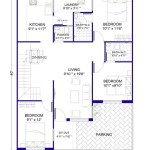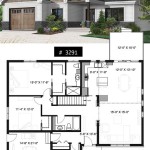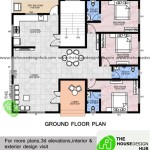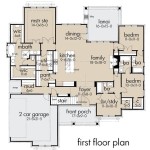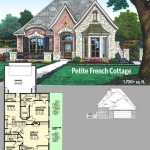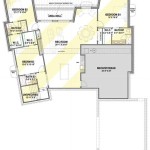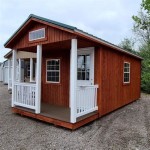2-Story House Plans With Attached Garage: A Comprehensive Guide
The combination of a two-story house plan with an attached garage offers a compelling blend of functionality, space efficiency, and potential cost savings. These designs are popular among homeowners seeking to maximize their living area on a limited lot size while maintaining the convenience and security of direct garage access. This article explores the advantages, design considerations, and various styles available within the realm of two-story house plans featuring attached garages.
Two-story homes inherently provide a larger footprint of living space compared to single-story homes occupying the same land area. This vertical expansion is particularly beneficial in densely populated areas or where land costs are high. Integrating the garage directly into the house plan further optimizes the use of the property, eliminating the need for a detached structure and the associated walkway.
The attached garage serves not only as a sheltered parking space but also as a potential entryway into the home, offering protection from the elements and enhancing security. Many designs incorporate a mudroom or foyer adjacent to the garage entrance, providing a designated area for storing outerwear, shoes, and other items, preventing clutter in the main living areas.
Benefits of Two-Story House Plans with Attached Garages
Several key advantages contribute to the popularity of two-story house plans with attached garages. These benefits extend beyond mere space efficiency and encompass lifestyle enhancements and potential financial considerations.
Increased Living Space: The primary benefit is the maximization of living area on a given lot. By building upwards, a two-story house significantly expands the available square footage without requiring a larger land purchase. This is particularly advantageous for families or individuals who require ample space for bedrooms, living areas, and home offices.
Cost-Effectiveness: Compared to building a sprawling single-story home of the same square footage, a two-story design can be more cost-effective. The foundation and roof areas are typically smaller, leading to reduced material and labor costs. While the construction of stairs adds an expense, it is often outweighed by the savings on the foundation and roofing materials.
Improved Security and Convenience: An attached garage provides a secure and convenient transition from the vehicle to the home, especially during inclement weather. This is particularly relevant for individuals with mobility challenges or those who frequently carry groceries or other items from the car. The attached garage also reduces the risk of theft or vandalism compared to a detached structure.
Enhanced Curb Appeal: Two-story homes generally offer a more visually impressive facade compared to single-story homes. The vertical architecture creates a sense of grandeur and allows for more elaborate architectural details. The attached garage can be seamlessly integrated into the overall design, contributing to a cohesive and aesthetically pleasing street presence.
Potential for Future Expansion: An unfinished space above the garage can easily be converted into an extra bedroom, home office, or recreational area. This provides flexibility for future needs and adds value to the property. The garage itself can also be adapted for various purposes, such as a workshop or storage area.
Design Considerations for Two-Story House Plans with Attached Garages
Designing a two-story house plan with an attached garage requires careful consideration of various factors to ensure optimal functionality, aesthetics, and compliance with local building codes. These considerations encompass the layout, structural integrity, and integration of the garage into the overall design.
Layout and Flow: The interior layout should prioritize a seamless flow between the garage, entry area, and main living spaces. A well-designed mudroom or foyer can serve as a buffer zone, preventing dirt and debris from entering the home. The placement of the staircase is also crucial, as it affects the circulation on both floors.
Structural Integrity: The attachment of the garage to the main house requires careful structural engineering to ensure stability and prevent settling issues. The foundation must be properly designed to support the weight of the house and the garage, and the connection between the two structures must be adequately reinforced.
Garage Door Placement and Style: The placement of the garage doors should be carefully considered in relation to the street and the overall aesthetics of the house. The style of the garage doors should complement the architectural style of the home, and the color should blend in with the exterior finishes.
Soundproofing: Given the proximity of the garage to the living areas, soundproofing is an important consideration. Insulating the walls and ceiling of the garage can help to minimize noise transmission from car engines, garage door openers, and other activities. Solid-core doors and weatherstripping can also help to reduce noise infiltration.
Ventilation: Proper ventilation is essential in the garage to prevent the accumulation of harmful gases, such as carbon monoxide. Exhaust fans can be installed to remove fumes and improve air quality. The garage should also be adequately ventilated to prevent moisture buildup, which can lead to mold and mildew growth.
Accessibility: Consider accessibility for individuals with mobility challenges. This may involve incorporating ramps or wider doorways in the garage and entry area. Elevators can also be installed in two-story homes to provide access to the upper floor.
Energy Efficiency: Insulating the garage walls and ceiling can help to improve energy efficiency and reduce heating and cooling costs. Energy-efficient garage doors and windows can also contribute to energy savings. Consider using insulated garage doors and sealing any gaps around the door frame.
Compliance with Building Codes: Ensure that the house plan complies with all applicable building codes and regulations, including those related to fire safety, structural integrity, and accessibility. Consult with a qualified architect or builder to ensure compliance with local requirements.
Styles of Two-Story House Plans with Attached Garages
Two-story house plans with attached garages are available in a wide range of architectural styles, catering to diverse tastes and preferences. Each style offers a unique aesthetic and features distinct characteristics that define its appearance.
Traditional Styles: Traditional styles, such as colonial, Georgian, and Victorian, feature symmetrical facades, formal layouts, and classic architectural details. These homes often have a prominent front porch, intricate trim work, and dormer windows. The attached garage is typically integrated seamlessly into the design, often with a recessed entrance or a carriage-style door.
Craftsman Styles: Craftsman-style homes are characterized by their emphasis on natural materials, handcrafted details, and a warm, inviting atmosphere. These homes often feature exposed rafter tails, wide eaves, and a prominent front porch with tapered columns. The attached garage is typically integrated into the design, often with a side entrance or a door that matches the exterior siding.
Modern Styles: Modern styles, such as contemporary and minimalist, feature clean lines, open floor plans, and a focus on functionality. These homes often have large windows, flat roofs, and minimal ornamentation. The attached garage is typically integrated into the design, often with a sleek, modern garage door.
Farmhouse Styles: Farmhouse styles are characterized by their simple, rustic aesthetic and connection to the outdoors. These homes often feature a gabled roof, board-and-batten siding, and a large front porch. The attached garage is typically integrated into the design, often with a barn-style door or a side entrance.
Transitional Styles: Transitional styles blend elements from both traditional and modern architecture, creating a balanced and versatile aesthetic. These homes often feature a mix of materials, such as brick, stone, and wood, and a combination of traditional and modern architectural details. The attached garage is typically integrated into the design, often with a door that complements the overall aesthetic.
Ranch Styles: Though less common in a two-story configuration, ranch-style homes can also adapt to a two-story plan with an attached garage. These homes generally emphasize single-level living, but the addition of a second story allows for increased space while maintaining some of the ranch aesthetic, often focusing on a more horizontal design.
Selecting the appropriate style depends upon personal preference, the surrounding neighborhood, and the overall desired aesthetic. Considerations for color, material choices, and detailing are all essential for creating a harmonious design.
In conclusion, selecting a two-story house plan with an attached garage requires diligent planning and considering several aspects. From the initial layout and structural considerations to the detailed decisions about garage door style and soundproofing, each choice contributes to the final functionality and aesthetic appeal of the home.

Trendy Two Story House Plans With Garage Drummond

Small 2 Story House Floor Plan With Car Garage

Unique Two Story House Plan Floor Plans For Large 2 Homes Desi Family Blueprints Victorian

A Popular Bungalow House Plan With 3 Bedrooms 2 Baths 2231

Two Story Four Bedroom House Plan With Garage

Plan 50132ph Cozy Bungalow With Attached Garage Cottage Floor Plans House Single Story

Trendy Two Story House Plans With Garage Drummond

2 Bed Modern Rugged House Plan With Attached Garage 22566dr Architectural Designs Plans

Stylish And Smart 2 Story House Plans With Basements Houseplans Blog Com

Custom 2 Story Houses New Two Home Plans Housing Development D House Layout Sims Blueprints

